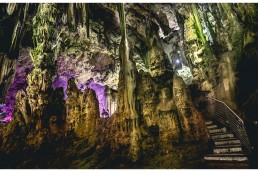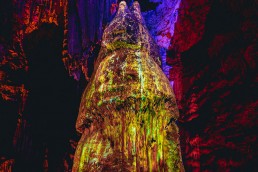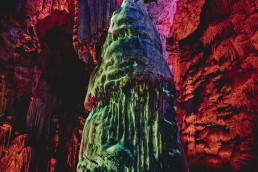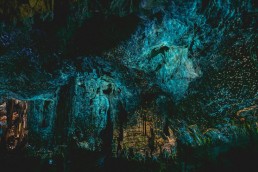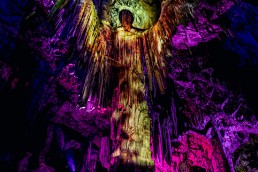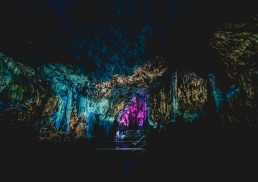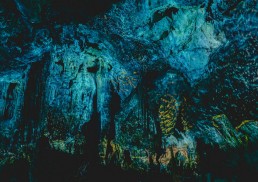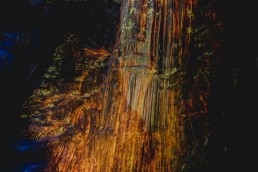This website uses cookies so that we can provide you with the best user experience possible. Cookie information is stored in your browser and performs functions such as recognising you when you return to our website and helping our team to understand which sections of the website you find most interesting and useful.
St. Michael’s Cave
ProjectSt. Michael’s CaveLocationGibraltarManufacturersCHAUVET Professional, Epson, VisBox, disguise, Medialon, TIMaxLighting DesignerPixel Artworks, Full ProductionInstallerFull Production, UKAcousticianZelig SoundSubmitted byCHAUVET Professional, Full Production and WrightTech Media
Zelig Sound provided a sound design using TiMax for spatial audio, while audio specialist Dan Roncoroni installed the immersive sound system. The team at Zelig had to come in and work almost blind, with the Pixel Artworks team being their eyes on the venue. Using the TiMax system really offered something special in each zone that enhances the immersive experience even further.
Accompanying Richardson and his team at Full Production on their odyssey was a collection of CHAUVET Professional IP fixtures that could withstand the punishing demands made by the cave, whilst still delivering performance that could accentuate and enhance its majestic beauty.
“The criteria we set were pretty tough,” said Richardson. “Our fixtures had to be very durable in an extremely harsh environment, as well as very flexible in terms of colour palette.”
Meeting these exacting standards were the Ovation E-910FC IP ellipsoidal and COLORado Solo 2 Wash, which offered the added benefit of a wide zoom range. A total of 35 of the RGBAL ellipsoidals (20 outfitted with 19ﹾ lens tubes and 15 with 26ﹾ ones), and 40 of the par units (all with 7.5-inch barn doors) are used at the attraction.
Located throughout the four projection canvases of the exhibit, the fixtures contributed to a lighting design that added depth and shape to the cave interior and accented its evocative features, whilst still allowing the natural aesthetics of the site to speak for itself.
“Essentially, our client brief for this show was to support the projection mapping produced by Pixel Artworks to create a colourful journey through the history of the caves,” said Richardson. “At the same time, we also wanted to have moments of reflection on the natural beauty of the cave.
“Each projection canvas has an ambient state where we use shadows, light and dark, and complementary colours to accent and highlight that area, “continued Richardson. “For example, there’s the ‘hero’ state, where each surface tells its story. Then there is the ‘beauty’ state, where the cave is in its “natural” form, very gentle, warm white, breathing.
“This cave is so wonderfully vast, we were able to use the shadows to our advantage,” he said. “We adopted a three-point system whereby most of the stalactites are lit from three sides – this allowed us to use intensity and colour changes to mold the rock and make it move, almost imperceptibly – but it’s there!”
With St. Michael’s Cave being a unique, popular tourist attraction we started to look at the sort of technologies that would work in a sympathetic manner to the natural aesthetic of the cave – and it seemed that projection mapping was the way forward. The most important aspect was spending as much time as possible in the cave and really understand the formations. That was all to help them learn what was going to help us in terms of projecting onto such a tricky surface. The mantra running through was to respect the site, they simply wanted to produce visuals and content to enhance the story-it wasn’t about exaggerating things, it’s letting these incredible geological thumbprints in time tell its own story. The Pixel Artworks’ team spec’d and installed Epson projectors and said that the medium of projection mapping is the perfect solution for St. Michael’s Cave, in that it’s not detrimental to the site itself. They actually did a full 3D scan of the cave to give us really detailed data, from which they created as highly detailled mesh. Using that mesh, they were then able to tailor the AV content and all their templates. “We actually took quite a complex route, as we were using real-time graphics and creating composite content live in the cave. That allowed us to really sharpen what worked and what didn’t. For the project, the cave was, essentially, split into two halves, with one side being for intimate, up-close views of the spectacular stalactites stalagmites and flow stones. The other side offers a main cathedral chamber, which really opens up into a large auditorium space. That approach in terms of projection mapping allowed us to offer a focus on the intricate art and beauty-using light and projection to allow visitors to see what they wouldn’t have been able to before, especially as the space can be quite overwhelming. The finale of the experience takes place within the main cavern known as Cathedral Cave, and uses a 360° light projection to recount an awe-inspiring story of geological formation.
Installation of the equipment within the cave required special consideration, to ensure no damage was done to the ancient rock formations and to preserve their visual integrity by positioning incongruous equipment out of sight. Pixel Artworks worked with WrightTech Media to obtain specially-designed casings, vinyl wrapping and armoured cables, that would also protect the equipment against the dampness and humidity within the cave, as well as preventing any damage by the famous Barbary macaques that roam freely around the site.
Of course, delays due to the Covid pandemic can’t be forgotten. The project originally started in 2019 with several site visits, but was frozen for a long period of time, until March 2021, when preparations started to have everything ready for the summer season.
Asked to describe the site, Richardson said: “Where to start? It is a massive cave, in a rock, in Gibraltar. It is damp, humid, hot, and massively acidic. It is pretty much the worst place to be installing lights. However, that said, the cave is also the hero. Nothing compares to its natural rock formations. There are stalactites in the millions there, ranging from small 300 to 900mm outcrops to large 12 to 30m structures. The cave and its history were the heroes – they were the two defining criteria in the design of this show.”
WrightTech Media and Pixel Artworks showed how St. Michael’s Cave could be used in a unique way to take the audience on an unforgettable journey through Gibraltar’s natural history, using projection mapping technology, lighting design and immersive audio.
“Thankfully, the Gibraltar government released an expression of interest with regards to improving the Upper Rock Nature Reserve. So, with St. Michael’s Cave being a unique, popular tourist attraction, it was a natural choice – particularly as there wasn’t much by way of technology there anyway. We started to look at the sort of technologies that would work in a sympathetic manner to the natural aesthetic of the cave – and it seemed that projection mapping was the way forward.”
“The aim of the project was to reinvigorate Gibraltar’s tourist industry, and I felt we needed something very visual and technology-based to engage audiences to a new level. My team knows the site very well, but it was great to get the fresh eyes of Pixel Artworks’ creative team, who spotted opportunities we hadn’t thought about, and also helped us to home in on the story we wanted to tell.”
The whole project is a spectacular combination of technologies in what is arguable one of the worst conditions to install them. It also takes care not to overpower the natural beauty of the site, but to enhance it through carefully selected techniques.
